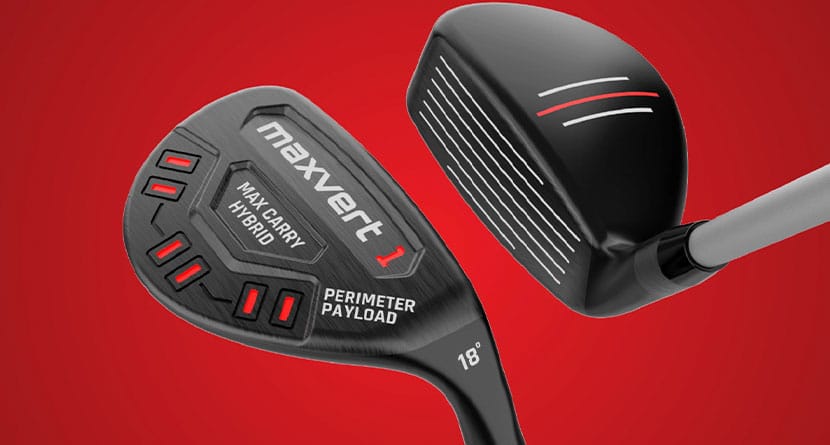What You Need To Know
- The VLS maxvert1 hybrid is the first hybrid golf club designed with recreational and golfers over 40 years old in mind
- The maxvert1 features a lightweight clubhead and shaft, draw bias weighting, more upright shaft angle and a “fairway finder” alignment guide
- maxvert1 comes in 18° and 22° and retails for $299.00 each, but SwingU readers get $100 off. You can buy both the 18° and 22° for a package deal of $299.00
There’s a rite of passage when you begin trading in your unforgiving long irons for a much more user-friendly hybrid.
Typically, that comes with a sheepish admission that you should have done it years sooner, but like any other shiny new club in your bag, the honeymoon period eventually wears off. It’s true that regardless of how forgiving a golf club is, a bad swing can make any shot difficult (that’s where instructors like Todd Kolb come in).
However, it’s also true that many of the clubs you’re putting in your bag because you saw a pro play them on television simply weren’t designed with you, the recreational player, in mind. That’s how Kolb will leave his mark – whether it be his Maxvert 1 Driver, his G-Track putter or the maxvert1 hybrid.
“There’s no doubt about it: hybrids changed the game for millions of ordinary golfers,” Kolb says. “And yet, they leave much to be desired – which goes double if you’re beyond age 40. I’ve seen firsthand the impact hybrids have made among the masses. Over time, I’ve also come to recognize these clubs’ flaws.”
So Kolb went to work ironing out those flaws, some more complex than others, in an effort to not only create a club specifically for recreational golfers, but to make the hybrid easier to hit for players of all ages and skill levels.

First Impressions
First and foremost, the maxvert1 is a good-looking golf club straight out of the box. Upon the initial and necessary post-unboxing waggle, your eye is immediately drawn to the crown of the club.
The matte black finish on the head emerges from an understated gray graphite shaft and accentuates what VLS calls its “fairway finder” alignment technology – a three-stripe aid on the crown of the club that brings to mind what we’ve seen Callaway do with their Triple Track golf ball alignment.
The next thing you notice is how naturally the club rests on the ground. Kolb preaches this in his design philosophy, and it was intentional.
“Some flaws are more complex, like the traditional hybrid’s sole shape,” he said. “It’s got a pronounced curvature, which might help a little in thick rough – but it actually makes the club harder to aim.”
Finally, and most interesting to me, there’s no doubt about the draw bias on this club. The clubhead sets on the ground as if it’s intentionally hooded, ready to wrap the ball right-to-left for that Tour-pro draw we all envy.
On The Course
As a hard-headed golfer (and potential egomaniac), I still keep a 2-iron in my bag. This TaylorMade UDI 17° is my best friend and worst enemy. When struck correctly, you can’t beat the sensation and performance, but more often than not, we’re playing our misses, which means clanky, skanky thin shots that squirt right and go further right.
Going head to head with the maxvert1, this was just the latest reminder that there is a better way. As mentioned above, there’s no fix for a bad swing. They happen and it’s our job to deal with it. But with the maxvert1, those bad swings are masked much better than with a long iron.
After a session of 2-irons that, even when struck well, had a left-to-right fade to them, and when completely mishit, went off the planet right, the maxvert1 was a breath of fresh air. Old habits die hard, so my consistent fight against that left-to-right fade/slice resulted in a quick hook the first time I swung the maxvert1.
The better news was the simple way you inherently fix that swing flaw, which is to do what Arnold Palmer said and just swing your swing. Instead of fighting the technology to make the ball draw, the maxvert1 is built to embrace that common out-to-in swing path that so many of us play.
Great swings with center-face contact result in towering high draws, while even those stinkers that hit the ball right at the equator and would typically be destined for the right trees, they hang tough down the right side of the fairway.
From a distance perspective, the 17° UDI and 18° maxvert1 were interchangeable on well-struck shots, and the hybrid was easily longer on average, given the built-in forgiveness.

The Takeaway
Having the pleasure of testing the maxvert1 only reinforced the words I wrote at the beginning of this review: I’m in need of that sheepish admission. While designed for golfers a little older than me, there’s no harm in embracing the technology and design genius that lives in each and every maxvert1 hybrid.
As a fader of the golf ball, it’s always an internal struggle for me of whether to play the fade or attempt to manufacture a straight ball or draw bias with some sort of contortion that typically results in a less-than-ideal strike. Those mental gymnastics are a thing of the past when you allow the maxvert1 to do what it’s designed to do. I found it difficult to fade the ball whatsoever (and that came on the heels of 10-15 balls that exclusively flew left-to-right).
All of that is to say, if you want to make the game easier on yourself, hit more consistent shots and not have to make any alterations to your swing, the maxvert1 is for you.
The maxvert1 hybrid comes in 18° and 22° and retails for $299.00 each, but SwingU readers get $100 off. You can buy both the 18° and 22° for a package deal of $299.00. Visit VLSGolf.com to learn more about the G-Track Putter and the rest of VLS Golf’s products.




